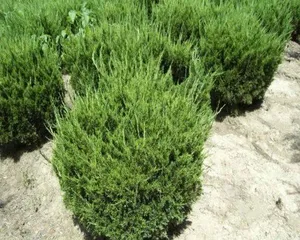Arborvitae, also known as "Money Pine", is a beautiful and practical ornamental plant widely used in landscaping. Arborvitae is popular for its well-developed root system, cold and drought tolerance, and rapid growth. However, in the process of maintenance, many people make some mistakes that lead to poor growth, slow growth, or the appearance of pests and diseases. Proper arborvitae maintenance is crucial.

Watering Tips - Be cautious with cold and hard water
Watering is a very important part of arborvitae care. Arborvitae does not require much water, so you don't need to water it too much each time, but the frequency should be appropriate, generally once a week is sufficient. When watering, avoid using cold and hard water. Cold water can stimulate the roots of arborvitae and slow down growth; while hard water has a high salt content, which can cause corrosion and damage to arborvitae.
Fertilizer Selection - Avoid over-fertilization
The growth of arborvitae requires the support of nutrients, so appropriate fertilization is essential. However, over-fertilization will cause arborvitae to absorb too many nutrients, damaging the roots and causing poor growth. When caring for arborvitae, we should pay attention to choosing the right fertilizer and mastering the appropriate amount during application.

Sunlight Exposure - Avoid prolonged exposure to the sun
Arborvitae is a sun-loving plant, but it should not be exposed to direct sunlight for long periods. During the hot summer months, excessive sunlight can cause the leaves of arborvitae to dehydrate, turn yellow, and even wither. When choosing a location to plant arborvitae, we should select a sunny but shaded place to ensure its normal growth.
Pest and Disease Control - Detect and treat in time
During its growth, arborvitae is susceptible to some pests and diseases, such as red spiders and aphids. When we find that the leaves of arborvitae are yellowing, curling, or drying up, we should carefully check whether the arborvitae has been infested by pests and take corresponding measures for timely treatment.
Pruning Methods - Proper pruning is beneficial for the beauty of the tree shape
The aesthetic appearance of arborvitae is very important, and proper attention should be paid to pruning during maintenance. Pruning can be done in spring and autumn, mainly to control the height and shape of the arborvitae. When pruning, pay attention to cut off excessive leaves and branches to give the arborvitae better growing space.

Suitable Temperature - Pay attention to cold protection and warmth
Arborvitae is a cold-tolerant plant, but it also needs protection from the cold in cold weather. Before winter arrives, we should take temperature protection measures, such as covering with a warm cloth. At the same time, if the indoor temperature is too high, it will also affect the arborvitae.
Precautions - Avoid keeping the roots of arborvitae moist
Arborvitae has a well-developed root system, and the roots are relatively sensitive. During maintenance, the roots of arborvitae should be kept from being damp for a long time to avoid rot. At the same time, arborvitae is not suitable for growing in a poorly ventilated environment. It should be planted in a place with good air circulation.
Watering Tips - Spraying water can increase humidity
Arborvitae is a plant that loves a humid environment, so we can use the method of spraying water to increase the humidity of the arborvitae's growing environment. When spraying water, we should avoid doing it under direct sunlight to prevent leaf scorch.
Fertilizer Selection - Organic fertilizers are more suitable
The growth of arborvitae requires the support of nutrients. When fertilizing, we should choose the appropriate fertilizer. Organic fertilizers are more suitable for the growth of arborvitae, allowing it to absorb more nutrients.
Sunlight Exposure - Regularly repot and change soil
After planting arborvitae for a period of time, the nutrients in the soil gradually decrease. At this time, we should regularly repot and change the soil. When changing the soil, pay attention to protecting the roots of arborvitae, and when replacing the new soil, try to choose a place with sufficient sunlight to allow the arborvitae to better absorb nutrients.
Pest and Disease Control - Prevention is the key
In the process of arborvitae maintenance, prevention is more important than treatment. We can conduct regular inspections to prevent pests and diseases from attacking arborvitae. At the same time, when planting arborvitae, we should choose high-quality seedlings and maintain environmental hygiene to prevent the occurrence of pests and diseases.
Pruning Methods - Maintain a stable tree shape
In the process of pruning arborvitae, we should pay attention to maintaining a stable tree shape. Pruning requires patience, gradually trimming step by step. If pruning is excessive, it will lead to poor growth of arborvitae.
Suitable Temperature - Pay attention to the temperature difference between day and night
During its growth, arborvitae needs an environment with a large temperature difference between day and night, which is beneficial for its growth and nutrient accumulation. When planting arborvitae, pay attention to choose a place with a large temperature difference between day and night.
Precautions - Avoid prolonged heavy rain
Although arborvitae likes a humid environment, prolonged heavy rain will also affect its growth. Soaking in water for a long time can easily cause the roots of arborvitae to rot, affecting growth. When the rainy season comes, we need to pay attention to drainage in time.
Arborvitae is a beautiful and practical ornamental plant. In the process of maintenance, it is necessary to pay attention to many aspects such as watering techniques, fertilizer selection, sunlight exposure, pest and disease control, pruning methods, suitable temperature, and precautions. Only by properly maintaining arborvitae can it grow healthily and vigorously, adding more green and vitality to landscaping.